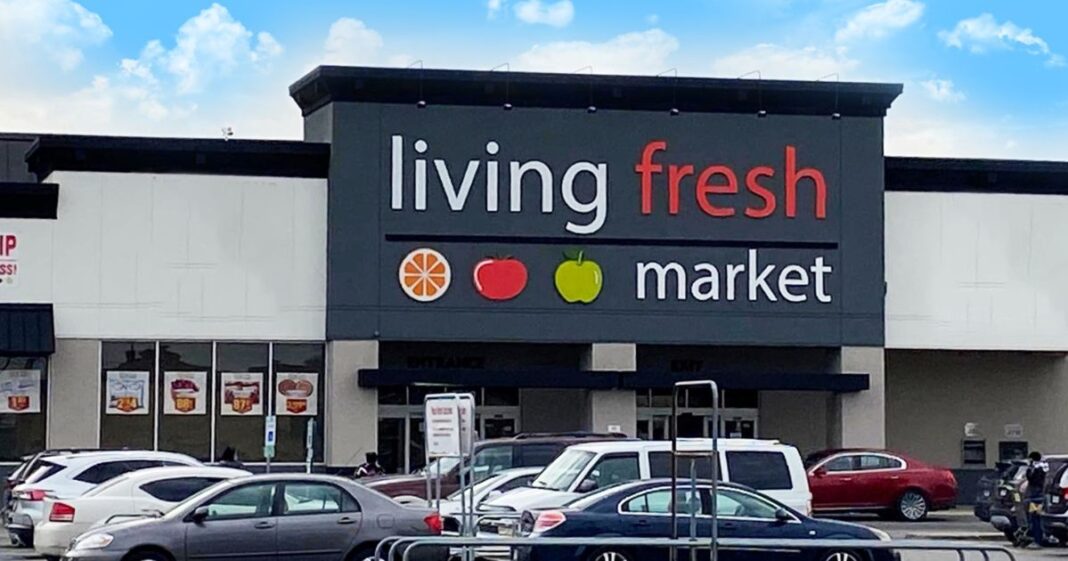In Chicago’s Forest Park, there’s a grocery store doing something remarkable. Living Fresh Market isn’t just selling groceries—it’s building generational wealth, creating jobs, and proving that minority small businesses can compete and win without compromising their values.
Opening a full-service supermarket is challenging in any market. Thin margins, fierce competition, supply chain pressures, and staffing challenges make grocery one of the toughest industries to crack. Yet Living Fresh Market has found a way to balance profitability with purpose: economic empowerment, faith-based values, and genuine community care.
This isn’t just another success story. It’s a blueprint for how minority small businesses can build legacy—not just revenue. Whether you run a restaurant, retail shop, service business, or online store, these seven lessons from Living Fresh Market will show you how to create something that lasts beyond your lifetime.
Source
“Living Fresh Market, A Black-Owned Grocery Store, Is …” Yahoo News, Feb 21, 2024. Yahoo
Additional details from Forest Park Plaza LLC acquisitions; Living Fresh’s own site; local coverage of its policies. Bronzecomm+3Yahoo Finance+3Living Fresh Market+3
Why This Story Matters for Minority Small Businesses
Minority small businesses face unique challenges: limited access to capital, systemic barriers, underserved markets, and the pressure to prove themselves in spaces where they’ve historically been excluded. Living Fresh Market demonstrates that these challenges don’t have to limit your vision.
At 71,000 square feet, this Black-owned supermarket competes directly with major chains. It offers a full deli, hot food station, butcher, seafood counter, bakery, salad bar, and juice bar. But what really sets it apart isn’t size—it’s the seven strategic decisions that minority small businesses can replicate at any scale.
Lesson 1: Let Your Values Drive Operations (Not Just Marketing)
The Wisdom
Most businesses claim to have values. Few actually operate by them. Minority small businesses have an opportunity to differentiate themselves by making values the foundation of every decision—from scheduling to pricing to partnerships.
The Living Fresh Example
Living Fresh Market closes every Monday. Not to save money, but to give employees a guaranteed day off for rest, family time, or worship—with no loss of pay.
This isn’t a marketing stunt. It’s a faith-based commitment that costs the business one-seventh of its potential weekly revenue. To offset the Monday closure for customers, they offer a 15% discount on all products every Tuesday.
These policies reflect the owners’ belief that employee wellbeing and customer care matter more than maximizing transactions. It’s a statement: we won’t sacrifice people for profit.
Your Action Plan
Define your non-negotiables. What does your business stand for beyond making money? Write down 3-5 core values that would guide you even in tough times.
Audit your operations. Do your policies—scheduling, pay, breaks, flexibility—actually reflect those values? If you say you value work-life balance but schedule staff with two days’ notice, there’s a gap.
Make values visible. Don’t hide your principles. Share why you make certain decisions. Customers who share your values will become loyal advocates.
Stay consistent. Legacy builds when you lean into your values repeatedly, especially when it’s inconvenient or costly.
For minority small businesses, values-based operations aren’t just good ethics—they’re competitive advantages. Customers increasingly want to support businesses that stand for something.
Lesson 2: Build Real Partnerships Within Your Community
The Wisdom
Minority small businesses thrive when they create networks of mutual support. Local sourcing, hiring from the neighborhood, and partnering with other minority vendors creates economic circulation that strengthens everyone.
The Living Fresh Example
Living Fresh Market actively seeks out Black-owned vendors. Their shelves feature products from Brown Sugar Bakery, Dominique Leach’s BBQ, and Brown Cow Creamery. When customers shop there, they’re not just buying groceries—they’re supporting a web of local entrepreneurs.
The store also prioritizes local hiring, ensuring that many staff members come from the same communities they serve. This creates jobs where they’re needed most and builds authentic connection between business and neighborhood.
Your Action Plan
Map your vendor ecosystem. Identify 5-10 minority-owned suppliers or service providers you could partner with. Start with one or two and build from there.
Hire locally whenever possible. Prioritize candidates from your immediate community. They understand your customers because they are your customers.
Create visibility for partners. Use in-store signage, social media, or email newsletters to spotlight the minority vendors you work with. Tell their stories.
Host collaboration events. Bring vendors into your space for tastings, demonstrations, or meet-and-greets. This builds community and differentiates your business.
For minority small businesses, these partnerships do double duty: they strengthen your supply chain while advancing economic equity in communities that need it most.
Lesson 3: Employee Care Is a Strategic Investment
The Wisdom
Minority small businesses often compete for talent against larger companies with bigger budgets. But you can win on culture, flexibility, and genuine care—things that matter more than salary for many employees.
The Living Fresh Example
Closing Mondays with full pay is more than generous—it’s strategic. Employees who feel valued work harder, stay longer, and represent your brand with pride. Living Fresh understands that rest isn’t a luxury; it’s what allows people to show up fully the other six days.
The Tuesday discount policy also shows systems-level thinking: they’re balancing customer benefit with employee rest, ensuring neither group feels neglected by the Monday closure.
Your Action Plan
Design rest into your operations. Even if you can’t close a full day, consider flexible scheduling, guaranteed time off, or mental health days.
Communicate the “why.” Tell employees why policies exist. When people understand the values behind decisions, they buy in.
Gather feedback regularly. Ask your team what would make their work experience better. Small changes can have huge impact.
Recognize publicly. Feature employees in your marketing, celebrate milestones, acknowledge contributions. Recognition costs nothing but builds loyalty.
For minority small businesses, strong employee care also helps with recruitment. Word spreads in communities, and being known as a great place to work gives you an edge.
Lesson 4: Make Trade-Offs With Integrity
The Wisdom
Every business faces trade-offs: quality vs. speed, margin vs. affordability, growth vs. stability. Minority small businesses often face an additional trade-off: short-term profit vs. long-term community impact. The businesses that build legacy choose the latter.
The Living Fresh Example
Closing Mondays costs revenue. Offering Tuesday discounts cuts margins. Supporting local vendors often means higher wholesale costs than bulk national distributors. Living Fresh accepts these trade-offs because they align with the business’s mission.
Owner Melody Winston explained these policies as rooted in faith and not relying solely on economic fluctuations. They made a deliberate choice to prioritize values even when it affected the bottom line.
Your Action Plan
List your current trade-offs. Where are you choosing between values and profit? Between convenience and quality? Write them down.
Decide which side reflects your mission. For each trade-off, determine which choice builds the legacy you want.
Be transparent about your choices. Customers respect businesses that make principled decisions, even when it affects pricing or availability.
Budget for values. Build these decisions into your financial planning so you’re not constantly second-guessing when times get tough.
Minority small businesses that make trade-offs with integrity often find that what they “lose” in short-term profit, they gain in customer loyalty and brand strength.
Lesson 5: Create an Experience, Not Just a Transaction
The Wisdom
Product quality matters, but how customers feel in your space matters more. For minority small businesses, creating a welcoming, dignified experience can be revolutionary—especially in communities that have been ignored or disrespected by larger businesses.
The Living Fresh Example
Living Fresh Market isn’t a bare-bones discount grocer. It’s bright, clean, spacious, and full-service. The deli, hot food bar, juice station, and bakery rival what you’d find in affluent suburbs. Staff are friendly and helpful.
Customers consistently mention feeling welcomed and valued—not just as buyers but as neighbors. This matters deeply in communities where grocery store deserts or low-quality options have been the norm.
Your Action Plan
Audit your space with fresh eyes. Walk through as if you’re a first-time customer. What feels inviting? What needs improvement?
Invest in ambiance. Clean regularly, improve lighting, update signage. Small changes create big perception shifts.
Train staff in hospitality. Friendly, knowledgeable service transforms transactions into relationships.
Add unexpected elements. Can you offer hot food, samples, seating, or other amenities that make your space more than just functional?
For minority small businesses, especially those serving underserved communities, elevating the experience sends a powerful message: your neighborhood deserves the best, and we’re here to deliver it.
Lesson 6: Use Distinctive Policies as Brand Identity
The Wisdom
Policies aren’t just operational—they’re storytelling tools. When minority small businesses create distinctive policies that reflect their values, those policies become part of the brand narrative.
The Living Fresh Example
Monday closures and Tuesday discounts aren’t typical grocery store policies. That’s exactly why they work. These decisions signal what Living Fresh stands for and give customers a reason to talk about the store.
The policies also create customer habits: regulars know to stock up on Tuesdays and avoid Mondays. This predictability builds routine while reinforcing the brand story.
Your Action Plan
Identify one signature policy. What’s one distinctive thing you could do that aligns with your values and would be memorable to customers?
Make it consistent and clear. Don’t change it based on convenience. Let it become part of your identity.
Tell the story behind it. Use signage, social media, or conversations to explain why you do things differently.
Use it in marketing. Your unique policies can become content, differentiators, and conversation starters.
For minority small businesses, distinctive policies help you stand out in crowded markets and give customers something to rally around beyond just products.
Lesson 7: Scale Your Mission, Not Just Your Size
The Wisdom
Growth is good when it amplifies impact. But for minority small businesses, expansion should replicate your mission in new communities—not just increase revenue.
The Living Fresh Example
Living Fresh Market is planning new locations in Maywood, Bronzeville, North Lawndale, and Tuskegee, Alabama. These aren’t randomly chosen markets—they’re underserved communities where the Living Fresh model of fresh food access, local jobs, and community investment can have maximum impact.
Each new store isn’t just about business expansion. It’s about bringing economic opportunity and dignity to neighborhoods that major chains have abandoned.
Your Action Plan
Codify what makes you special. Before scaling, document your policies, culture, training methods, and values. This becomes your expansion blueprint.
Choose mission-aligned locations. Expand into markets where your business model can create meaningful impact, not just where rent is cheap.
Build systems first. Ensure you have management, supply chains, and training programs that can support growth without losing quality.
Measure impact beyond revenue. Track jobs created, local partnerships formed, and community feedback alongside financial metrics.
For minority small businesses, thoughtful expansion multiplies your impact while creating the generational wealth that communities need.
The Bigger Picture: Legacy Over Profits
Living Fresh Market proves that minority small businesses don’t have to choose between profitability and purpose. The store demonstrates that values-driven decisions—closing for rest, hiring locally, supporting minority vendors—actually build stronger customer loyalty and brand distinction.
For minority entrepreneurs, especially those in underserved communities, these lessons matter beyond business success. They’re about building generational wealth, creating representation, and uplifting entire neighborhoods.
Here’s what Living Fresh Market teaches us:
- Let values guide operations, not just marketing
- Build authentic community partnerships
- Invest in employee care strategically
- Make trade-offs with integrity
- Create experiences that honor your customers
- Use distinctive policies as brand identity
- Scale mission alongside size
You don’t need a 71,000-square-foot store to apply these principles. Whether you run a restaurant, boutique, consulting firm, or online shop, these strategies work at any scale.
The question isn’t whether you can afford to operate this way. It’s whether you can afford not to. Minority small businesses that build with values, community care, and long-term vision don’t just succeed—they create legacies that outlast their founders.
Your Next Step
Choose one lesson from this article. Just one. Implement it this month. Maybe it’s reaching out to a minority vendor, creating a distinctive policy, or redesigning your employee schedule around rest.
Small changes, repeated consistently, build legacy.
What will your business be remembered for?
Want more stories about minority small businesses building legacy? Subscribe to get practical insights delivered to your inbox.




